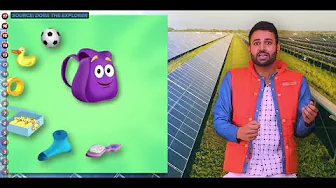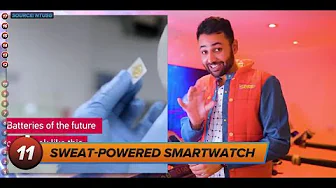Intro

You've seen 2D printers, you've seen 3D printers, but did you know that the first 4D printers have already been built? They use special smart materials to fabricate objects that can change their shape in response to stimuli like heat or moisture, even after the printing process is already over, adding the fourth dimension of time to already existing three-dimensional shapes. Which means that 4D printers can pump out completely ready-to-use finished products. Literally anything from roads that can self-heal themselves to working human organs. But we're just getting started. You're about to see 16 of the coolest inventions that are about to define how we live our lives in the future. So, when you think of a screen, what do you think of? A flat phone screen? A flat screen TV? Maybe even a display that can fold itself in half? But just last month, Samsung unveiled their Flex Hybrid, which combines both the folding and rolling display to enable a large, fully functional tablet to pack away into just a fraction of its size. And it's basically Samsung saying, " Whatever you want your displays to be able to do, we can make that happen". And so very soon, expect to see mainstream TVs that can roll up to hide away from view. And this is even cooler, even smartphones that can scale their displays to automatically fit the content that's being shown. But if flexible screens are the future that we do want, then wireless, battery-powered screens are the future that we probably don't.
DISPLACE WIRELESS TV

The company Displace recently showed us their completely wireless 55-inch 4K TV prototype. I mean, most TVs only need a power lead at this point anyway, but this takes it even further by running solely on four huge batteries. And there's a lot of stuff to like here. It comes with no remote, relying solely on hand gestures to navigate, and you don't even need to install wall-mounting brackets. You just stick it somewhere and it'll stay, thanks to Displace's vacuum sealing technology. I love how clean that sounds. But you might have noticed the one little problem here. The vacuum that's keeping the screen stuck onto the wall obviously is going to run off the same batteries that are powering the screen itself. So when those batteries run out, it might also be displacing your floorboards. I mean, it's probably fine. If you lived in a bonnet, whose idea was this? Bazinga! Every now and again, though, thinking outside the box does pay off. Like with Wi-Fi. In the exact same way that Wi-Fi allows us to transmit data using radio waves, the German physicist Harald Haas realized that light can be an even more powerful tool. You basically have an LED bulb that can turn on and off so quickly that the human eye can't even detect it. To send binary on/off signals, just like radio waves carry. Except that because light travels much faster than radio waves, the potential ceiling for Li-Fi is about 100 times faster than Wi-Fi. The only real drawback being that because the signals are made of light, they can't penetrate walls at all. But then again, for people who want security, that's also one of its biggest perks. Because it's literally impossible to interfere with unless you're sitting in the same room. Li-Fi's not about to take over the world tomorrow, given how entrenched our lives already are with Wi-Fi, but it is absolutely perfect for some specific situations like military communications and getting internet access to planes. Plus, I mean, if we get to a stage in the future where we've literally reached the speed limit of Wi-Fi and we do need the next thing, you might well one day be asking your friend for the light bulb password. Now, when you're not using it to send data, we already know that you can also absorb light to power our homes. This usually requires installing large, cumbersome solar panels.
SOLAR PANEL STICKERS

But in 2022, scientists at MIT managed to use semiconducting inks to print a set of solar cells thinner than a strand of human hair. They weigh a hundredth of a typical solar panel. And because they're just the stuff you need and nothing else, they're pound for pound 18 times more efficient at generating electricity than typical panels. That's such a difference that the types of possibilities start to change. Like, it's not just that you can now install them onto the roofs of buildings, but you could stick them on drone propellers to get extra flight time, on backpacks to charge your phones while you're walking out and about. They're actually really significant for disaster relief. Like, let's say that a country has just had an enormous flood. Then being able to send them 5,000 solar panels all packed up into one little box is the absolute fastest way to get them to start generating power again and get back on their feet. But if we trace it all the way back, the reason that the sun is always churning out solar energy in the first place is because it's constantly undergoing a process called nuclear fusion.
NUCLEAR FUSION

Where because it's so unbelievably hot there, lighter atoms are given enough energy to be able to fuse together with each other to form heavier atoms. The heavier atoms weigh less than the sum of the two lighter atoms, meaning that some of that total mass is lost in the process, being released in this case as energy to power things. And so, what if instead of scooping up some solar energy when it eventually arrives at Earth, we just cut out the middleman and harness that process ourselves, inside a fusion reactor? Using supercharged lasers to get things really hot and fuse atoms together in a controlled environment, producing a huge implosion of energy from that reaction. Milo's arrived, everyone's favourite science teacher. He's a very well educated cat. Anyways, for a long time this has been considered an extremely difficult, almost pointless quest. Especially since every single attempt thus far has used more energy heating up the particles than it's produced from the fusion itself. Until December 2022, when scientists in the US announced that they had finally achieved something called ignition. For the first time in history, the fusion reactor produced more energy than they put in to start the reaction. Proving that it's not only theoretically possible, but that we can actually do nuclear fusion. Which, because it runs on hydrogen atoms, the most abundant element in the universe, means that we could have a near limitless source of energy with absolutely zero carbon footprint. But as well as these longer term solutions, we also need to start finding cleaner sources of energy for now. Because, I mean, the burning of fossil fuels still accounts for 80% of the world's energy usage. And we're kind of running out of them. That's what this next invention does. If you were to guess how a wearable device could draw power from just your body, you'd probably say kinetic energy from the movement, or electrical energy from your nervous system. But what if I told you that you could power your smartwatch with just... sweat?
SWEAT-POWERED SMARTWATCH

Scientists at the Nanyang University in Singapore have created a battery that's smaller than one square inch, but can react with the chloride ions in human sweat to produce electricity. The part that makes it absolutely ideal, though, for wearable devices like this, is that they also fixed it to a flexible fabric cuff that absorbs sweat so that the battery can carry on being powered even when they're not actively sweating. So in a weird kind of way, that fabric becomes the backup battery. The tech isn't at a level right now where it could completely run your high power Apple Watch on, but it is generating not insignificant amounts of power. So at the very least, this tech could keep your existing smart gadgets just running for longer. Oh, and a sub to the channel would be... Treadmendous.
But why stop at wearing tech when you can become the tech?
SMART TATTOOS

At least, that's the idea of smart tattoos, which now I think about it, really does sound like something out of cyberpunk. Smart tattoos are effectively personalised circuits that can be glued to your body, powered by sweat in the exact same way, and able to execute commands upon being triggered. Like no joke, playing your favourite song when touched. Right now, the maximum time we've managed to get one of these tattoos to last is about two weeks, because of the simple fact that humans are constantly shedding skin. But if that hurdle can be overcome, the idea of a fully customisable, on-body connection to the smart world around you is pretty tantalising. But with number 9, it's time to go even deeper. No, like literally. Inside the body.
MICROCHIP IMPLANTS

Because if you wanted something more... permanent, then microchip implants are a real thing that people are already starting to get. And even though we're quite far off from the whole " my arm is a smartphone" under-skin display systems, what you can still get is an RFID tag to store important medical data that can be scanned if you're ever found unresponsive. Or an NFC tag that allows you to unlock your door or pay for things using your wrist. Okay, time to change lanes.
PARALLEL REALITY BOARDS

Number 8 solves a problem that we've been living for so long that we didn't even realise there's a better way. Airport departure boards, and how they have to cram hundreds of different flight details into one single board. But just last year, a researcher at Delta Airlines created a technology that basically eliminates that, admittedly first world, problem forever. By making it so that when you look at the screen, you're only seeing the information that's relevant to you. Or in other words, a parallel reality display. The screen has special individually lit pixels that, unlike normal pixels which display one tone of light in all directions, can actually display hundreds if not thousands of different colours depending on the angle that you look at them from. And so, when you pair that with a motion sensor that knows which passenger is looking at the screen from which angle, it can make sure that from that angle, all the pixels are lighting up in such a way that all that passenger sees are their own flight details, loud and clear. I really hope this one takes off. And wouldn't it be crazy if every billboard showed you personalised adverts? Or every road sign you drove past showed you directions specific to where you needed to go? It's gonna be a very interesting world. Number 7 then is Spin Launch.
SPINLAUNCH

And this one's fixing a much bigger problem than just having to stare hard at a board a few times a year. So there are currently over 5,000 active satellites orbiting this Earth. And it's estimated that by 2030, we are going to have launched 10 times that number. If we want to get high speed internet in all parts of the world, you're going to need more satellites. But that does cause a problem. Launching heavy objects like this all the way into space is extremely fuel intensive. Like there are some NASA aircraft that are consuming fuel at 2 million times the rate of a normal family car during ignition. But that's where Spin Launch comes in. A new launching system that's starting in 2025 that's basically one giant vacuum seal wheel in which the satellite is spun as fast as possible with no air resistance because remember it's a vacuum and then just let go. At which point the satellite has so much momentum that it can nearly reach all the way to space without even starting to use fuel. I really love it when people approach old problems with a fresh pair of eyes. And Spin Launch is going to pay off in a big way when it comes to future greenhouse gas emissions. Being able to launch satellites using 4 times less fuel with 10 times less cost and being able to launch multiple satellites on the same day from the same site. But future emissions are one thing. If we're really going to fix this planet, we also need to clean up the mess that we've already made.
DIRECT AIR CAPTURE

And one of the most fascinating ways to potentially do that is direct air capture. Which instead of just reducing the amount of greenhouse gases we're letting into the air - which I would say is a much harder problem to solve because you have to tell people don't live your life the way you want to live your life - is instead about taking excess carbon dioxide back out of the air. It works by using a large fan to draw air into a chamber. And then that chamber contains a special chemically active filter which traps only the carbon dioxide particles. Then the chamber is heated to 100 degrees Celsius, causing the CO2 to evaporate into a pipe that sends it all the way underground. And then the purified air gets released back above the surface. And then because you've actually managed to separate the pure carbon dioxide - as opposed to it just intermingling with our current existing air but making it worse - you can actually do some useful stuff with it too. Like make fuels or plastics or fertilizers. The list goes on. Okay, one thing you need to know about me is that I am absolutely obsessed with dinosaurs. I've watched every single Jurassic Park film the week they came out. And spent about half my childhood wishing that just like in the movies, some scientist could just discover some old fossil, extract the DNA and bring these creatures back to life. Now the only slight problem is that unlike in Jurassic Park's story, DNA decays over time. Which means that if we actually wanted to artificially recreate an extinct creature, we can't just find a sample that's preserved in amber and use that DNA.
REVIVING EXTINCT SPECIES

But what we're slowly realising that we can do is work using the DNA of animals that are currently alive. And so there is a very real company right now called Colossal who is planning to use elephant DNA and tweak it to match what they predict the DNA of its long-extinct ancestor, the woolly mammoth, was like. This means that if they then planted that DNA into the womb of an African elephant, this company is absolutely convinced that that elephant will actually give birth to a living, breathing woolly mammoth. I mean this is both one of the most incredible things I've ever seen. It means we could basically recreate any species, promoting biodiversity, repopulating the earth and, from what these guys are saying, restoring the natural balance. But it does also feel like the plot of a disaster movie. Like we have no idea how prehistoric creatures will interact with modern day ecosystems. They might be incredibly helpless compared to their modern day peers and die out very quickly. But what could actually be disastrous is if they were actually really aggressive and they killed off one of our existing different species. I've never been more torn in my entire life. But incredibly, de-extinction is not the only 90s sci-fi prediction that's actually become a reality.
FLYING CAR

Because we've also now got fully functional flying cars. This is the Aska A5. It's a four-seater, mostly electric, flying car with a series of wings and drone-like propellers that work together to give it a top airspeed of 150 miles per hour and a total range of 250 miles per charge. And this has legitimate benefits. Because of the windy nature of roads, and obviously traffic, it would take you roughly two hours to drive a normal car 100 miles on, let's say, a UK road. If you flew one of these instead, it would take you just 40 minutes. It is absolutely phenomenal to think that this works. It's just that the way that we've built our current transport infrastructure makes it quite a useless proposition in practice. Like you can't drive this thing on a road. What if you're like this and a big lorry pulls in next to you? Either you're losing a wing or they're losing a head. And then if all you wanted to do was to just fly, if you just went to an airport like a normal person, you would find yourself on a plane that can travel closer to 500 miles per hour over three times faster. Oh yeah, and the Aska also costs about $789,000. Still, it's a slight catch. Now we're down to the top three, the most earth-shaking inventions in the tech world. Starting with neural interfaces.
NEURAL INTERFACE

Microchips that aren't just somewhere in your body but actually directly connected to your brain, can read your brain signals and use those signals to communicate wirelessly with other pieces of technology. Neural interfaces are already being used in healthcare to treat hearing loss, tremors caused by Parkinson's disease, and even paralysis. There was a really wholesome moment recently where a paralysed patient was actually able to talk to his family by just spelling out one letter at a time, just by learning to concentrate on those letters with his mind. And Elon Musk's Neuralink company has actually got some even more ambitious goals, like potentially being able to download data into your mind, send a friend a text on the other side of the world without even having to move, or just watch full feature-length movies like Fast and Furious 72 in your head. There's actually so much to say about what Neuralink is doing right now though. So if enough of you tell me that you want to see that, I'll make a dedicated video just about it. Okay, it's time to talk about whales. Whales are actually incredibly intelligent animals, and what's interesting about them is that their way of communicating is the closest thing to human language in the entire animal kingdom - a combination of clicks, whistles and squeaks known as pulse calls. It is so advanced to the point where killer whales, for instance, literally have different languages that they learn from their parents. And so if you took one killer whale from the Pacific and one killer whale from the Atlantic, they wouldn't understand each other. But artificial intelligence is getting sophisticated enough that it's not just going to be capable of letting different types of whales understand each other, but also for us to understand them.
TRANSLATING WHALE LANGUAGE

This whole project is called the Cetacean Translation Initiative, and step one is for them to gather a bunch of different sound recording mechanisms, including hydrophones attached to buoys, electronic tags to attach to whales themselves, and even robotic fish that can go thousands of feet deep to record whales in their natural habitat. And they're going to use these devices to try and record roughly one billion individual clicks. Once they've got that, they can then run this data through an AI that specialises in natural language processing. And this is where it gets interesting, because this AI should then be able to look at all of this data at once, find the context in which certain clicking sounds are repeatedly used. For example, it might notice that certain types of clicks are used just before the whales start to hunt. And since this AI is able to look at vast quantities of data simultaneously, it can sort them into a language map that then allows it to predict the future meaning of clicks that it hears from then on. And I mean, think about it, if that works, this means we could not only be able to translate what they're saying, but we could talk back to them. I just want to make sure this is sinking in. We're talking about literally the first step in interspecies communication. But then I discovered that xenobots were a thing. Programmable, self-healing, living robots. Scientists basically took stem cells from a specific species of African frog and, using a supercomputer to figure out the exact right shape, recreated their own machine versions of them by hand with miniscule tools under a microscope. These robots can gather together into clumps of hundreds of cells, perform programmed tasks, and even reproduce, shooting out xenobot offspring from this bigger clump. This is the pinnacle of modern technology. You can use them in surgery, to deliver drugs within a person's bloodstream to the precise location they're needed in the body, or you can even just chuck a load into the ocean in huge swarms to gather and clean up dangerous microplastics. For the next video on gadgets that can save your life, that's here, and I will see you there.
1 Page 2 of 9 Page 3 of 9 Page 4 of 9 Page 5 of 9 Page 6 of 9